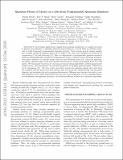Notice
This is not the latest version of this item. The latest version can be found at:https://dspace.mit.edu/handle/1721.1/141456.2
Quantum phases of matter on a 256-atom programmable quantum simulator
| dc.contributor.author | Ebadi, Sepehr | |
| dc.contributor.author | Wang, Tout T | |
| dc.contributor.author | Levine, Harry | |
| dc.contributor.author | Keesling, Alexander | |
| dc.contributor.author | Semeghini, Giulia | |
| dc.contributor.author | Omran, Ahmed | |
| dc.contributor.author | Bluvstein, Dolev | |
| dc.contributor.author | Samajdar, Rhine | |
| dc.contributor.author | Pichler, Hannes | |
| dc.contributor.author | Ho, Wen Wei | |
| dc.contributor.author | Choi, Soonwon | |
| dc.contributor.author | Sachdev, Subir | |
| dc.contributor.author | Greiner, Markus | |
| dc.contributor.author | Vuletić, Vladan | |
| dc.contributor.author | Lukin, Mikhail D | |
| dc.date.accessioned | 2022-04-01T15:01:45Z | |
| dc.date.available | 2022-04-01T15:01:45Z | |
| dc.date.issued | 2021 | |
| dc.identifier.uri | https://hdl.handle.net/1721.1/141456 | |
| dc.description.abstract | Motivated by far-reaching applications ranging from quantum simulations of complex processes in physics and chemistry to quantum information processing, a broad effort is currently underway to build large-scale programmable quantum systems. Such systems provide unique insights into strongly correlated quantum matter, while at the same time enabling new methods for computation and metrology. Here, we demonstrate a programmable quantum simulator based on deterministically prepared two-dimensional arrays of neutral atoms, featuring strong interactions controlled via coherent atomic excitation into Rydberg states. Using this approach, we realize a quantum spin model with tunable interactions for system sizes ranging from 64 to 256 qubits. We benchmark the system by creating and characterizing high-fidelity antiferromagnetically ordered states, and demonstrate the universal properties of an Ising quantum phase transition in (2+1) dimensions. We then create and study several new quantum phases that arise from the interplay between interactions and coherent laser excitation, experimentally map the phase diagram, and investigate the role of quantum fluctuations. Offering a new lens into the study of complex quantum matter, these observations pave the way for investigations of exotic quantum phases, non-equilibrium entanglement dynamics, and hardware-efficient realization of quantum algorithms. | en_US |
| dc.language.iso | en | |
| dc.publisher | Springer Science and Business Media LLC | en_US |
| dc.relation.isversionof | 10.1038/S41586-021-03582-4 | en_US |
| dc.rights | Creative Commons Attribution-Noncommercial-Share Alike | en_US |
| dc.rights.uri | http://creativecommons.org/licenses/by-nc-sa/4.0/ | en_US |
| dc.source | arXiv | en_US |
| dc.title | Quantum phases of matter on a 256-atom programmable quantum simulator | en_US |
| dc.type | Article | en_US |
| dc.identifier.citation | Ebadi, Sepehr, Wang, Tout T, Levine, Harry, Keesling, Alexander, Semeghini, Giulia et al. 2021. "Quantum phases of matter on a 256-atom programmable quantum simulator." Nature, 595 (7866). | |
| dc.relation.journal | Nature | en_US |
| dc.eprint.version | Original manuscript | en_US |
| dc.type.uri | http://purl.org/eprint/type/JournalArticle | en_US |
| eprint.status | http://purl.org/eprint/status/NonPeerReviewed | en_US |
| dc.date.updated | 2022-04-01T14:46:59Z | |
| dspace.orderedauthors | Ebadi, S; Wang, TT; Levine, H; Keesling, A; Semeghini, G; Omran, A; Bluvstein, D; Samajdar, R; Pichler, H; Ho, WW; Choi, S; Sachdev, S; Greiner, M; Vuletić, V; Lukin, MD | en_US |
| dspace.date.submission | 2022-04-01T14:47:11Z | |
| mit.journal.volume | 595 | en_US |
| mit.journal.issue | 7866 | en_US |
| mit.license | OPEN_ACCESS_POLICY | |
| mit.metadata.status | Authority Work and Publication Information Needed | en_US |
